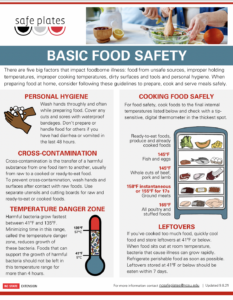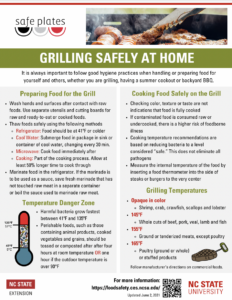Tailgating Season Is Here! Keep It Food Safe
go.ncsu.edu/readext?892352
en Español / em Português
El inglés es el idioma de control de esta página. En la medida en que haya algún conflicto entre la traducción al inglés y la traducción, el inglés prevalece.
Al hacer clic en el enlace de traducción se activa un servicio de traducción gratuito para convertir la página al español. Al igual que con cualquier traducción por Internet, la conversión no es sensible al contexto y puede que no traduzca el texto en su significado original. NC State Extension no garantiza la exactitud del texto traducido. Por favor, tenga en cuenta que algunas aplicaciones y/o servicios pueden no funcionar como se espera cuando se traducen.
Português
Inglês é o idioma de controle desta página. Na medida que haja algum conflito entre o texto original em Inglês e a tradução, o Inglês prevalece.
Ao clicar no link de tradução, um serviço gratuito de tradução será ativado para converter a página para o Português. Como em qualquer tradução pela internet, a conversão não é sensivel ao contexto e pode não ocorrer a tradução para o significado orginal. O serviço de Extensão da Carolina do Norte (NC State Extension) não garante a exatidão do texto traduzido. Por favor, observe que algumas funções ou serviços podem não funcionar como esperado após a tradução.
English
English is the controlling language of this page. To the extent there is any conflict between the English text and the translation, English controls.
Clicking on the translation link activates a free translation service to convert the page to Spanish. As with any Internet translation, the conversion is not context-sensitive and may not translate the text to its original meaning. NC State Extension does not guarantee the accuracy of the translated text. Please note that some applications and/or services may not function as expected when translated.
Collapse ▲Football season is well upon us, and you know what that means…….TAILGATING! Time for rivalries, heartbreaks, high fives and fist bumps, and of course, delicious food off of the grill. But, with all of the excitement over hard knocks, we need make sure we don’t fumble when comes to food safety. In this article we will go over some strategies you can add to your playbook to make sure everyone enjoys the festivities.
First things first, any successful gameplan begins with proper preparation. Make sure that your hands, surfaces, and utensils are clean and remember to wash hands frequently during food preparation. Make sure you are wearing clean clothes and cover any cuts or wounds with water proof bandages. Do not prepare or handle food if you are sick.
After taking time to prep properly, we can now focus on the food! Many of the foods we enjoy during tailgates, mainly meats and foods containing animal products, need to be cooked to a proper internal temperature. For those items we can use a food thermometer to gauge if these dishes have reached the proper internal temperature. For example, ground meats like hamburgers, need to reach an internal temperature of 155F before it is safe to eat. Please view the infographic to see proper internal temperatures of other commonly prepared items. Take care to prevent cross-contamination by keeping raw foods that need to be cooked separate from fully cooked foods or foods that do not need to be cooked.
A couple of pre-snap items to note, be mindful of how you thaw your food before preparation. Foods can be thawed safely either in the refrigerator, using cool water, using the microwave (if cooking immediately afterward), and as part of the cooking
process. Also, keep in mind that if marinating, make sure keep the item being marinated in the fridge during that process. Also, do not use that same marinade as a sauce unless it is boiled first.
Next we have to make sure we keep our food our of the red zone….I mean danger zone! The Temperature Danger Zone is a range of temperature where bacteria grows the fastest (41F – 135F). Making sure food does not stay in this temperature range for long reduces the risk of bacteria scoring…. I mean making people sick. Food should not be left in this range for more than 4 hours. In other words, keep hot foods hot and cold foods cold, and try to move foods through the danger zone as quickly as possible when refrigerating. Refrigerate food perishable food as at the conclusion of the meal or within that 4 hour window, or discard if left out longer. To cool foods quickly break them down in to smaller containers. Lastly, whatever leftovers you have, make sure to consume or toss those within 7 days.
For more information feel free to reach out to our FCS Agent Jordan Jefferies-James or checkout our Food Safety Page.






